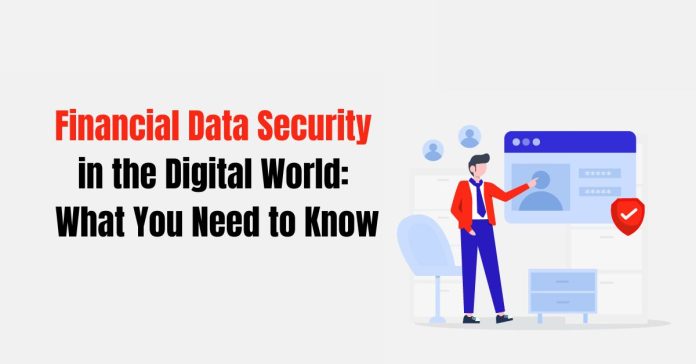Are you tired of receiving spam emails, calls from fake companies, and unauthorized transactions from your bank account? Well, you’re not alone. With the increasing use of FinTech software development, financial data security has become a hot topic for businesses and consumers alike. Whether it’s through online banking, mobile payments, or e-commerce transactions, our financial data is constantly at risk of being stolen by cybercriminals.
But don’t panic just yet! In this article, we will guide you through the essentials of financial data security in the digital world. From common threats to best practices, we’ll equip you with the knowledge you need to protect yourself and your finances. We’ll also explore the latest regulations and compliance standards, and offer some tips on what to look for when choosing financial institutions and services.
Let’s dive into the nitty-gritty of financial data security.
Common Threats to Financial Data Security
Let’s start by exploring one of the most common threats to financial data security:
Phishing scams
Phishing scams are a type of social engineering attack where cybercriminals impersonate legitimate entities, such as banks or credit card companies, in order to steal sensitive information from unsuspecting victims. These scams can be conducted through various channels, including email, phone calls, text messages, and even social media.
So, how do you recognize and avoid phishing scams? One key factor is to always be suspicious of unsolicited requests for personal information, such as passwords or credit card details. Legitimate entities typically do not ask for sensitive information via email or other electronic means. Additionally, you should carefully examine the sender’s email address, as phishing emails often use fake or spoofed addresses that resemble legitimate ones.
Malware attacks
Another common threat to financial data security is malware attacks. Malware is a type of software that is designed to infiltrate or damage computer systems, often with the intent of stealing sensitive information. Examples of malware include viruses, worms, and Trojan horses. Malware attacks can be initiated through a variety of means, such as clicking on a malicious link or downloading a corrupted file.
To recognize and avoid malware attacks, it’s important to maintain strong cybersecurity practices. This includes using reputable antivirus software, avoiding suspicious websites and downloads, and being cautious of unsolicited emails or messages. Additionally, you should always keep your software and operating system up-to-date, as software vulnerabilities can often be exploited by malware.
Password Hacks
Lastly, password hacks are a growing threat to financial data security. Password hacks occur when cybercriminals gain unauthorized access to user accounts by stealing or cracking passwords. This can happen through a variety of means, such as phishing scams or brute-force attacks.
To create strong passwords and prevent password hacks, you should use a combination of upper and lower-case letters, numbers, and symbols. Additionally, you should avoid using the same password across multiple accounts, as this can make it easier for hackers to gain access to multiple accounts if they are able to crack one password. Furthermore, you should enable two-factor authentication whenever possible, as this provides an additional layer of security that makes it more difficult for hackers to gain access to your accounts.
Overall, by being aware of common threats such as phishing scams, malware attacks, and password hacks, and taking proactive measures to prevent them, you can significantly reduce the risk of financial data theft. Remember to stay vigilant, and don’t hesitate to seek help from cybersecurity experts if you suspect any suspicious activity on your accounts.
Best Practices for Financial Data Security
Here are some best practices to keep in mind:
Use of Secure Connections and Networks
Secure connections and networks are crucial to ensure the protection of financial data. This means using encrypted connections and secure networks to prevent any unauthorized access or interception of sensitive information.
To use secure connections and networks, you should always connect to websites or financial institutions using secure protocols such as HTTPS. Additionally, make sure your Wi-Fi network at home or work is secured with a strong password and encryption.
Two-factor authentication is a security method that requires two forms of identification to access an account or system. This helps to prevent unauthorized access even if a password is compromised.
Examples of two-factor authentication:
Examples of two-factor authentication include receiving a text message with a code or using an app such as Google Authenticator to generate a code that you enter along with your password.
To set up two-factor authentication, you can usually find the option in the security settings of the account or app. Follow the prompts to enter your phone number or set up the authentication app.
Regularly monitoring financial accounts can help you detect any suspicious activity or transactions early, before it becomes a bigger issue. This can help prevent financial loss or identity theft.
How to regularly monitor financial accounts:
To regularly monitor financial accounts, set up alerts for any transactions or changes to your accounts. Review your accounts regularly, especially after any major purchases or changes to personal information.
Explanation of why it is important to keep software up-to-date:
Keeping software up-to-date helps to patch any security vulnerabilities and ensure that you have the latest security features to protect against threats.
To keep software up-to-date, enable automatic updates if available. Otherwise, regularly check for updates and install them promptly. This includes updating your operating system, browser, and any financial apps you use.
Regulations and Compliance
When it comes to financial data security, regulations and compliance are no joke. Here are some things you should know:
Overview of current regulations and compliance standards for financial data security:
To keep your financial data safe, there are several regulations and compliance standards that financial institutions must follow. Some of the most well-known standards include the Payment Card Industry Data Security Standard (PCI DSS) and the General Data Protection Regulation (GDPR). These standards help ensure that financial institutions are taking the necessary steps to protect your sensitive information from unauthorized access.
Explanation of how these regulations and standards impact consumers:
These regulations and standards impact consumers by providing an extra layer of protection for their sensitive financial data. This means that you can have more peace of mind when using financial services and making transactions online. Additionally, financial institutions that comply with these regulations and standards are typically more trustworthy and reliable, making them a better choice for consumers.
What to look for when choosing financial institutions and services:
When choosing a financial institution or service, there are several things you should look for to ensure that they are compliant with relevant regulations and standards. For starters, make sure the institution has a good reputation and a track record of protecting their customers’ data. You can also look for certifications or badges that indicate compliance with specific standards. Additionally, be wary of institutions that ask for unnecessary personal information or that have poor online security features.
So, there you have it, my financially savvy friend! By being aware of current regulations and compliance standards and knowing what to look for when choosing financial institutions and services, you’ll be on your way to keeping your financial data secure and sound. And remember, while financial data security may not be the most exciting topic, it’s definitely worth taking seriously!
Conclusion
As we wrap up this article, I’d like to leave you with a few final thoughts and recommendations. First and foremost, take financial data security seriously. It’s not something you want to mess around with. And if you’re facing challenges in securing financial data or feeling unsure about how to protect yourself, don’t be afraid to seek out professional help. There are plenty of experts out there who can assist you in safeguarding your financial information.
In conclusion, let’s all do our part to stay safe and secure in this digital world. After all, we’ve got more important things to worry about, like whether or not our favorite TV show will get renewed for another season. Am I right?
Author Bio:-
 Himanshu is a digital marketing expert at Peerbits having a proven track record of delivering successful marketing campaigns for small and large businesses. He has huge expertise in strategic planning, brand development, content marketing, social media management, and e-commerce optimization. He is skilled at managing cross-functional teams, building strong relationships with clients, and staying up-to-date on the latest digital marketing trends and techniques. In his free time, he enjoys playing basketball, traveling, and trying out new restaurants in his city.
Himanshu is a digital marketing expert at Peerbits having a proven track record of delivering successful marketing campaigns for small and large businesses. He has huge expertise in strategic planning, brand development, content marketing, social media management, and e-commerce optimization. He is skilled at managing cross-functional teams, building strong relationships with clients, and staying up-to-date on the latest digital marketing trends and techniques. In his free time, he enjoys playing basketball, traveling, and trying out new restaurants in his city.




















![TamilMV Proxy List Top 30+ [Unblock TamilMV Sites] TamilMV Proxy Unblock](https://technewsgather.com/wp-content/uploads/2023/04/17825836_SL-121019-25870-14-1-100x70.jpg)